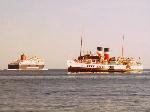 50 years of Clyde steamers, as the 2-year old Caledonian Isles passes
the 48-year old Waverley off Brodick (August 1995)
50 years of Clyde steamers, as the 2-year old Caledonian Isles passes
the 48-year old Waverley off Brodick (August 1995)

(All photographs are © Iain Murray 2011 - click on the small pictures to see a larger picture)
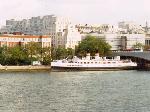 On the Thames (1995); the building on the left is the Institution
of Engineering & Technology (formerly the Institution of Electrical Engineers).
On the Thames (1995); the building on the left is the Institution
of Engineering & Technology (formerly the Institution of Electrical Engineers).
Queen Mary was a turbine steamer built to serve the various resorts around the Clyde. In this she was very popular, being a large and comfortable vessel. However, as Clyde cruising waned in popularity and fuel costs continued to rise, she was withdrawn by Caledonian MacBrayne in 1977. Laid up for some time, she was refurbished as a floating restaurant on the Thames at Westminster Bridge (replacing the former Clyde paddler Caledonia which had been burnt out) where she remains today. Converted to oil burning in the fifties, she was given a single funnel, but her double funnel profile was restored for her static role. Note: she officially became Queen Mary II from 1934 when her name was given to the Cunard liner, but her old name was restored in 1976. At the end of 2009, she was towed down the Thames for a new life as a restaurant and fitness centre in La Rochelle, France, but appears to have made it only as far as Tilbury.
 Arriving Millport (16th July 1998)
Arriving Millport (16th July 1998)
The Second Snark was built by William Denny of Dumbarton for use as a tug and tender at their shipyard, replacing their previous vessel The Snark (adventurous naming policy, huh?). When Denny's closed in the early sixties, she was engaged in cruising on the Forth, but since 1969 she has been owned by Clyde Marine Motoring who still use her for Clyde Cruising throughout the summer.
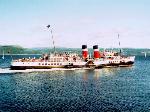 Departing Dunoon (9th July 1996)
Departing Dunoon (9th July 1996)
Waverley is the Clyde steamer everyone's heard of! She entered service in 1947, being the last (and only post-war) paddle steamer built for Clyde service. Originally in LNER colours, she assumed the CSP yellow funnels on nationalisation, later with lions as on other Clyde vessels. She briefly bore the red funnel of Caledonian MacBrayne in 1973 before being sold (for £1) to the Paddle Steamer Preservation Society, who refurbished her to continue in coastal cruising, billed as the "last sea-going paddle steamer in the world". As such, she has toured all the Clyde resorts, many of the Western Isles, as well as making annual excursions to England.
 50 years of Clyde steamers, as the 2-year old Caledonian Isles passes
the 48-year old Waverley off Brodick (August 1995)
50 years of Clyde steamers, as the 2-year old Caledonian Isles passes
the 48-year old Waverley off Brodick (August 1995)
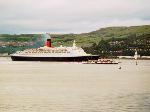 Real Clyde cruising as the Waverley escorts the Queen
Elizabeth 2 past the Cloch lighthouse (6th July 1996)
Real Clyde cruising as the Waverley escorts the Queen
Elizabeth 2 past the Cloch lighthouse (6th July 1996)
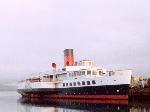 On a misty morning at Balloch (8th October 1996)
On a misty morning at Balloch (8th October 1996)
An honorary Clyde steamer, having been built on the Clyde, then dismantled and reassembled at Loch Lomond, making her the largest inland steamer ever in the UK (she was also originally owned by the Caledonian Steam Packet Company)! She performed regular sailings on the loch into the 1980s when she became too uneconomical and was laid up. She has sat decaying at Balloch since, though recently she was taken over by the local council and work has started on reviving her. This has included giving her a CalMac-style black lower hull, though she has always had an all-white hull previously.
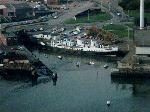 In Dundee as a "floating" pub (1984). The area in this picture has now
been extensively refurbished - the inlet is now the dry dock housing Captain
Scott's vessel R.R.S. Discovery, with the Discovery Point visitor
centre to the left. The station forecourt across the road is also unrecognisable
today.
In Dundee as a "floating" pub (1984). The area in this picture has now
been extensively refurbished - the inlet is now the dry dock housing Captain
Scott's vessel R.R.S. Discovery, with the Discovery Point visitor
centre to the left. The station forecourt across the road is also unrecognisable
today.
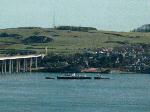 Being towed down the Tay; the Tay Road Bridge is on the left (March 1985).
Being towed down the Tay; the Tay Road Bridge is on the left (March 1985).
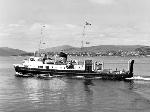 Maid of Cumbrae departing Gourock in final condition
Maid of Cumbrae departing Gourock in final condition
Maid of Cumbrae was one of four small passenger motor vessels in 1953 for use on various Clyde services. By the early seventies, all were redundant and were withdrawn. Maid of Cumbrae was reprieved and converted to a car ferry to serve with the Glen Sannox on the Gourock-Dunoon service until the arrival of the Jupiter and Juno in 1974. Maid of Cumbrae was sold to Italy where she rejoined Maid of Skelmorlie which had been converted to a car ferry in similar fashion, serving as the Capri Express and Ala respectively. Capri Express was scrapped at Aliagi, Turkey, in 2006. Maid of Argyll was sold to Greece, serving in a heavily modified condition as the City of Piraeus and subsequently City of Corfu. She caught fire and sank while alongside at Mandouki, Corfu, where her hulk remains. Maid of Ashton is now the Hispaniola restaurant ship at the Embankment in London.
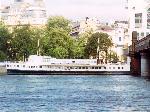 Hispaniola (ex Maid of Ashton) on the Thames; Charing Cross
station is to the right (1995)
Hispaniola (ex Maid of Ashton) on the Thames; Charing Cross
station is to the right (1995)
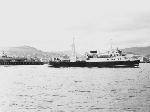 Departing Dunoon in original condition (after radar was fitted)
Departing Dunoon in original condition (after radar was fitted)
Arran was the first of the Clyde car ferries, and the last Clyde vessel built by Messrs. Denny of Dumbarton. She was designed as a "general purpose" vessel, carrying passengers in the forward accommodation, cargo in the stern section (served by a goalpost derrick), and cars in a main deck garage. As linkspans were not an option at the time, she was fitted with an electric hoist which allowed her to load cars from existing piers at all states of the tide. With her sisters Bute and Cowal, she was intended to operate three services (to Dunoon, Rothesay and Brodick), but traffic on the Gourock-Dunoon service meant that this route was usually operated by two vessels. It was quickly found that cargo handling was more easily done using the vehicle hoist, so in 1959 the derrick was replaced with a more conventional mainmast and the cargo space opened up for additional car capacity.
In this condition, the three vessels served throughout the sixties. The Cowal continued to serve on the Clyde until withdrawn in 1977 and sold to Greece. Bute had her lift extended and served on the Mallaig-Armadale service until withdrawn in 1979 and also sold to Greece (neither vessel saw service in Greece and both were scrapped in 1984). Arran transferred to the Islay service from 1970 in a service swap with the new Iona; when it became apparent that Iona would not move to Islay, Arran was modified in early 1973 to become a stern-loader, with additional accommodation added forward of the wheelhouse. On the arrival of Pioneer, she became spare vessel and in 1975 had a starboard side ramp refitted to allow her to again serve Dunoon. She was withdrawn in 1979.
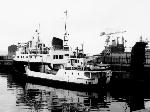 Laid up in Greenock (1979) in 1975-1979 condition, with Coll
Laid up in Greenock (1979) in 1975-1979 condition, with Coll
Laid up until 1984, she was sold to an Irish consortium including TV host Eamonn Andrews, and taken to Dublin where she was converted to a floating nightclub, with the car deck being built up to boat deck level. However, the consortium fell through and she was towed to Salford via the Manchester Ship Canal for use in the Salford Quays project. However, financial problems hit her new owners also, and she lay unattended in the dock until scrapped in 1992.
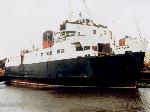 In final condition, Salford (1989)
In final condition, Salford (1989)
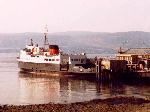 At Wemyss Bay (September 1984)
At Wemyss Bay (September 1984)
Glen Sannox was built to offer a car ferry service to Arran, and was essentially a larger version of the ABC-Class ferries on the upper Clyde services. She was very successful on the Arran route until replaced by the drive-through Caledonia in 1970. She then had a stern ramp fitted (her crane was later removed also) and she served a number of routes; Gourock-Dunoon, Wemyss Bay-Rothesay, contract work to Ardyne, and even Clyde cruising on the withdrawal of the Queen Mary. She also did general relief work which took her to most ports around the Clyde and Western Isles. Notably, she usually spent the winter on the Oban-Craignure (Mull) service until the arrival of Isle of Mull in 1989 made her redundant. She was sold to Greece as the Knooz where she was extensively modified for service in the Red Sea as the Al Marwah. Her hulk now rests in a partly sunk condition on the west coast of Saudi Arabia.
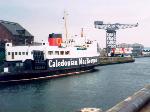 The old and the new - Glen Sannox in her last year with the new
Lord of the Isles fitting out behind, Greenock (April 1989)
The old and the new - Glen Sannox in her last year with the new
Lord of the Isles fitting out behind, Greenock (April 1989)
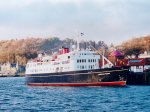 At Oban North Pier (March 1999)
At Oban North Pier (March 1999) 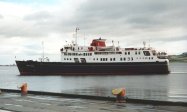 First arrival at Dundee (11th November 2000)
First arrival at Dundee (11th November 2000)
Columba, Hebrides and Clansman were built in 1964 to offer car ferry services to the main West Highland routes. Replaced by new vessels towards the end of the 80s, the Clansman went to the Middle East via Malta, and Hebrides offered an excursion service from Cornwall to the Channel Islands as the Devoniun. Columba stayed in service until 1989, when she was lavishly converted into a cruise ship and renamed Hebridean Princess. She can still be seen regularly in West Highland waters, offering cruises through the spectacular scenery and fine cuisine. A one-week cruise costs around £1500.
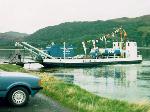 At Rhubodach, Bute (July 1985)
At Rhubodach, Bute (July 1985)
Portree and half-sister Broadford were built for the popular crossing from Kyle of Lochalsh to Kyleakin (Skye). Both were side loaders, although the Portree had her bridge structure forward. When displaced by the new Lochalsh and Kyleakin in 1971, the vessels were converted to bow loading (Portree had her bridge moved to the stern making her virtually indistinguishable from Broadford) and used on the recently acquired Colintraive-Rhubodach (Bute) service, where they operated until displaced by the Loch-class in 1986, when they were sold.
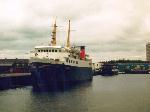 In Victoria Dock, Dundee (1988)
In Victoria Dock, Dundee (1988)
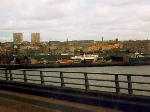 From the Tay Road Bridge, Dundee (1988)
From the Tay Road Bridge, Dundee (1988)
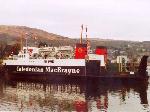 At Ardrishaig (May 1990)
At Ardrishaig (May 1990)
Iona was built for David MacBrayne Ltd. to serve Islay from West Loch Tarbert, but as a suitable terminal could not be built, she entered service on the Gourock-Dunoon route for a couple of years. She then served Stornoway briefly before becoming the main Outer Isles vessel from Oban. In 1979, she did take up the Islay service (the Western Ferries terminal having been acquired) and was latterly the main vessel on the Mallaig-Armadale (Skye) summer service, being spare in winter. She has called at all major piers in the CalMac domain, except (curiously) Kilcreggan. She was sold in 1997 for service across the Pentland Firth, being renamed Pentalina B (catchy, huh?), but the service did not start until May 2001, sailing between Gill's Bay and St Margaret's Hope. With the arrival of the new Pentalina in 2008, the old ship returned to occasional charter work including Dover-Dunkirk, but in late 2009 was sold to the Cape Verde islands off the west coast of Africa. State-of-the-art when built and well-travelled, but sure is a whole lot of ugly in one place.
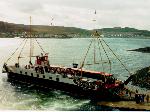 At Kyle of Lochalsh (September 1988)
At Kyle of Lochalsh (September 1988)
Lochalsh and her sister Kyleakin (similar except for mast structure) were built to replace a host of small ferries (including the Portree) on the main Skye service. They served this route well until replaced by the larger Loch Dunvegan and Loch Fyne in 1991. Lochalsh and Kyleakin now serve in the Republic of Ireland as the Glenbrook and Carrigaloe respectively. Loch Dunvegan and Loch Fyne were themselves made redundant by the new Skye bridge, and are now on other duties.
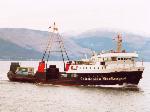 Approaching Gourock (17th March 1988)
Approaching Gourock (17th March 1988)
Jupiter was built to serve on the Gourock-Dunoon service, and has operated this route or the Rothesay (Bute) service ever since (though she can also serve Arran if required). Originally, her car deck bulwarks were white and she had no flying bridge, but on the appearance of the Juno, she was modified and is now virtually identical to the Juno. Being propelled by fore and aft Voith-Schneider units, she is extremely maneuverable, and this has given her and her sisters the nickname "streakers". She originally bore the legend "GOUROCK-DUNOON FERRY" along her sides, but this was removed in 1984 and replaced with "Caledonian MacBrayne" the following year. As with the other "streakers", her lifeboats were replaced with other life-saving apparatus to reduce crewing requirements. After a period laid up at Rosneath, she was towed to Denmark in late June 2011.
 Approaching Gourock (18th April 1995)
Approaching Gourock (18th April 1995)
Juno was built to partner the Jupiter on the Dunoon service, and has always served there or on the Bute service. After several years laid up at Rosneath, she was scrapped there in summer 2011; her builder's plate and a funnel lion were saved for the Maclean Museum in Greenock.
 Departing Ullapool (September 1988)
Departing Ullapool (September 1988)
Suilven was bought off the stocks as a replacement for the underpowered Clansman on the Ullapool-Stornoway (Lewis) service. She was closely associated with that route until replaced by the larger Isle of Lewis in 1995. Suilven was sold for service between the north and south islands of New Zealand, later moving to Fiji, but has not been renamed.
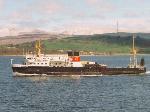 Departing Gourock (18th April 1995)
Departing Gourock (18th April 1995)
Pioneer was built to replace the Arran on the Islay service from West Loch Tarbert (as Iona could not operate from far up the loch). Originally she was a stern-loader only, with two small cargo cranes just abaft of the superstructure. When Iona took over the service from Kennacraig in 1979, Pioneer took over the Mallaig-Armadale (Skye) service from the Bute. For this duty, she was fitted with a hoist for use at both piers. Displaced again by the Iona in 1989, she became spare boat and had the hoist removed again, although the side ramps were retained. Latterly seen in service on the Dunoon or Rothesay services alongside the "streakers" (though aesthetically she is less appealing, her colouration giving the impression that she is slightly bent in the middle), she was sold in 2004 for further service in the Gulf of Guinea off West Africa as the Brenda Corlett.
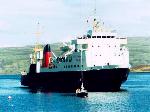 Arriving at Tobermory, Mull (May 1989)
Arriving at Tobermory, Mull (May 1989)
Claymore was built to replace Iona on the Outer Isles service from Oban, and ten years later replaced her again on the Islay service. When replaced herself by the Isle of Arran in 1993, she became spare, and has been used for a variety of relief duties. In recent years, her main deployment has been on the seasonal Ardrossan-Isle of Man service, acting as relief vessel in the winter. In April 1997, she was sold for use on a new summer Kintyre-Northern Ireland service, though this was not a success. She is now Danish-owned and believed to be operating as the Sia on cable laying duties.
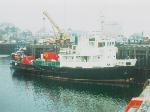 At Mallaig as the Lochmor (September 1988)
At Mallaig as the Lochmor (September 1988)
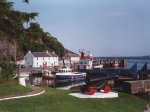 At Port Askaig, Jura (1998) - picture by Richard Campbell
At Port Askaig, Jura (1998) - picture by Richard Campbell
Eilean Dhiura was built to replace Western Ferries' Sound of Jura on the short crossing between Port Askaig (Islay) and Feolin (Jura). The vessel is operated on behalf of Argyll & Bute Council, and entered service in 1998.
Go to the Caledonian MacBrayne unofficial web page or the Caledonian MacBrayne official web page
Go to Iain Murray's home page or send me an e-mail
Go to the Applied Computing home page
Go to the University of Dundee home
page